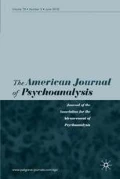References
Benjamin, J. (2004). Beyond doer and done to: An intersubjective view of thirdness. Psychoanalytic Quarterly, 73, 5–46.
Bion, W. R. (1955). Language and the Schizophrenic. In M. Klein, P. Heimann & R. E. Money-Kyrle (Eds.) New directions in psycho-analysis: The significance of infant conflict in the pattern of adult behavior (pp. 220–239). New York: Basic Books.
Bion, W. R. (1959). Attacks on linking. International Journal of Psycho-Analysis, 40, 308–315.
Bollas, C (2006). Perceptive identification. Psychoanalytic Review, 93, 713–717
Bolognini, S. (2011). Secret passages. London: Routledge.
Ferenczi, S. (1932). The clinical diary of Sandor Ferenczi. Dupont, J. (Ed.), Balint, M. & Jackson, M. Z. (tr). Cambridge: Harvard University Press, 1988.
Fromm, E. (1964). Humanism and psychoanalysis. Contemporary Psychoanalysis, 1, 69–79.
Geller, J. (2007). Freud’s Jewish body. Mitigating circumcisions. New York: Fordham University Press.
Ghent, E. (1990). Masochism, submission, surrender. Contemporary Psychoanalysis, 26, 169–211.
Gilman, Sander L (1992). Freud, race and gender. American Imago, 49, 155–183.
Green, A. (1975). The analyst, symbolization and absence in the analytic setting (on changes in analytic practice and analytic experience) in memory of D.W. Winnicott. International Journal of Psycho-Analysis, 56, 1–22.
Groddeck, G. (1923). The book of the It. (V.M.E Collins, tr). New York: International Universities Press. Re-published in 1976.
Heimann, P. (1955). A combination of Defense Mechanisms in Paranoid States. In M. Klein, P. Heimann & R. E Money-Kyrle (Eds.) New directions in psycho-analysis. The significance of infant conflict in the pattern of adult behavior (pp. 240–265) New York: Basic Books.
Horney, K. (1945). Our inner conflicts: A constructive theory of neurosis. New York: W.W. Norton.
Miller, I. (2016). Defining psychoanalysis: Achieving a vernacular expression. London: Karnac.
Nadler, S. (1999). Spinoza: A life. Cambridge: Cambridge University Press.
Ogden, T. H. (1994). The analytic third: Working with intersubjective clinical facts. International Journal of Psycho-Analysis, 75, 3–19.
Sullivan, H. S. (1955). The interpersonal theory of psychiatry. London: Tavistock.
Thomas, W.I. (1951). In E. H. Volkart (Ed.) Social behavior and personality: Contributions of W.I Thomas to theory and social research. New York: Social Science Research Council. Reprinted, Greenwood Press.
Winnicott, D. W. (1949). Hate in the counter-transference. International Journal of Psycho-Analysis, 30, 69–74.
Wolstein, B. (1974). “I” processes and “me” patterns—two aspects of the psychic self in transference and countertransference. Contemporary Psychoanalysis, 10, 347–357.
Author information
Authors and Affiliations
Corresponding author
Rights and permissions
About this article
Cite this article
Miller, I. Beyond Doer and Done To: Recognition Theory, Intersubjectivity and the Third, by Jessica Benjamin, Routledge, London and New York, 2018, 278pp.. Am J Psychoanal 78, 308–313 (2018). https://doi.org/10.1057/s11231-018-9151-8
Published:
Issue Date:
DOI: https://doi.org/10.1057/s11231-018-9151-8

